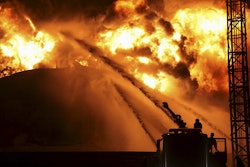Compressed air dryers and filters are designed and rated to treat specified volumes of air at specific conditions. A refrigerated dryer, for example, is rated to achieve a specified dew point at a particular volume (scfm), pressure (100 psig), compressed air temperature (100 degrees F), and ambient temperature (100 degrees F). These are typically referred to as “standard conditions.”
If system pressure is not constant, the air velocity through clean air treatment equipment will fluctuate. When air velocity is high, dryers and filters are not as effective. For those operating 24 hours a day, fluctuation may be minor. If, however, compressors are shut down for any length of time (overnight, weekends, holidays), system pressure will drop significantly as air escapes through leaks. Until full, or near full operating pressure is reached, dryers and filters may not work to specification and contaminants may be swept downstream.
A velocity control valve installed downstream of air treatment components reduces excessive velocity through these components by automatically opening and closing to maintain a set minimum pressure in the supply side of the air system while charging the main distribution piping. This prevents damage and increases the effectiveness of air treatment equipment. It also pressurizes the entire air system in the shortest possible time.
This valve protects air treatment components from extended exposure to high velocity air while the system is being pressurized. After the air system has been pressurized, the velocity control valve also prevents exposure of air treatment components to possible overflow conditions. Leaks, artificial demand, and unregulated uses all affect the total demand for air. If the total demand reduces the system pressure, the increased air velocity may reduce the effectiveness of air treatment components. The velocity control valve prevents this condition, ensuring that dryers and filters will be able to operate according to their rated specifications.
Maintaining air quality and protecting air treatment components are a typical concern for anyone with a compressed air system. Incorporating this valve into the system design can be a simple way to ensure your air quality will not suffer.
This blog entry is an excerpt from the whitepaper, “The Effects of Rapid System Pressurization on Air Treatment Components: Limiting Exposure to Excessive Air Velocity.” To download a complimentary copy of the whitepaper, visit www.kaeser.com/whitepapers.



















